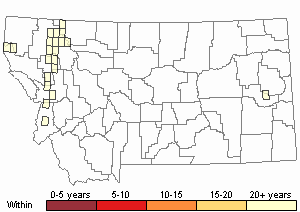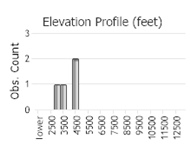View in other NatureServe Network Field Guides
NatureServe
Montana
Utah
Wyoming
Idaho
Wisconsin
British Columbia
South Carolina
Yukon
California
New York
A Claopodium Moss - Claopodium bolanderi
General Description
Plants: Pleurocarpous (Vitt 1988). Growing in slender mats, green or green with yellow tones. Stems creeping, as long as 6 cm, with erratic branching; paraphyllia scale-like, not always present (FNA 2014).
Leaves: Curved inward and twisted when dry, upright and spreading when wet, egg-shaped (FNA 2014), narrowed suddenly to the long, hyaline apex (Lawton 1971), as long as 1.6 mm in length (FNA 2014), ca 0.4-0.6 mm in width (Lawton 1971); margins saw-toothed, vaguely bordered (FNA 2014); apex slender, piliferous; base slightly auriculate and extending down the stem (Lawton 1971); costa pellucid, not reaching the apex, the dorsal side smooth. Branch leaves resembling stem leaves (FNA 2014).
Leaf Cells: Alar cells not distinct from surrounding cells; upper and medial laminal cells nearly square to 6-sided, short, each with several papillae (FNA 2014) on both upper and lower lumen surfaces; hair-point cells and basal juxtacostal cells smooth or less papillose than upper and medial laminal cells; cells of the leaf edge also with fewer papillae and sometimes longer than adjacent cells (Lawton 1971).
Diagnostic Characteristics
Claopodium crispifolium is similar to C. bolanderi, but grows at lower elevations (to about 3280 feet) and more commonly on wood than on rock (Lawton 1971).
Range Comments
North American Range
AK, BC and AB, s to CA, ID and MT (FNA 2014). Known in Montana from Flathead, Glacier, Lake, Lincoln, Missoula, Ravalli, Sanders, and Teton Counties (Elliott 2016).
Observations in Montana Natural Heritage Program Database
Number of Observations: 58
(Click on the following maps and charts to see full sized version)
Map Help and Descriptions
Relative Density

Recency



 (Observations spanning multiple months or years are excluded from time charts)
(Observations spanning multiple months or years are excluded from time charts)
Habitat
Rock and soil (Elliott 2016), seldom on wood (Lawton 1971). Elevations: medium to high (FNA 2014), to 6560 feet (Lawton 1971).
Reproductive Characteristics
Dioicous. Perigonia tiny, occurring on the stems, the leaves ca 0.5 mm in length. Perichaetia arising from the stem (Lawton 1971). Seta coarse, 10-15 mm in length. Capsule brown, 1.2-1.8 mm in length, nearly level to inclined (FNA 2014) or drooping (Lawton 1971), contracted proximal to the mouth when dry; operculum long-beaked; exostome divisions lance-shaped, bordered, with numerous delicate ridges and papillae, the papillae above and below; endostome cilia knobby (FNA 2014).
Specialized vegetative reproduction not present (FNA 2014).
Stewardship Responsibility
References
- Literature Cited AboveLegend:
 View Online Publication
View Online Publication Elliott, J.C. and A.K. Pipp. 2018. A Checklist of Montana Mosses (1880-2018). Updated 3 January, 2020. Montana Natural Heritage Program, Helena, Montana. 73 pp.
Elliott, J.C. and A.K. Pipp. 2018. A Checklist of Montana Mosses (1880-2018). Updated 3 January, 2020. Montana Natural Heritage Program, Helena, Montana. 73 pp. Flora of North America Editorial Committee, eds. 2014. Flora of North America North of Mexico. Volume 28. Bryophytes: Mosses, Part 2. Oxford University Press, Inc., NY. xxi + 702 pp.
Flora of North America Editorial Committee, eds. 2014. Flora of North America North of Mexico. Volume 28. Bryophytes: Mosses, Part 2. Oxford University Press, Inc., NY. xxi + 702 pp. Lawton, E. 1971. Moss Flora of the Pacific Northwest. Hattori Botanical Laboratory. Japan: Yamabuki-cho, Shinjuku-ku, Tokyo. 362 pages plus appendices.
Lawton, E. 1971. Moss Flora of the Pacific Northwest. Hattori Botanical Laboratory. Japan: Yamabuki-cho, Shinjuku-ku, Tokyo. 362 pages plus appendices. Vitt, D. J. Marsh, and R. Bovey. 1988. Mosses, Lichens & Ferns of Northwest North America. Seattle, WA: University of Washington Press. 296 p.
Vitt, D. J. Marsh, and R. Bovey. 1988. Mosses, Lichens & Ferns of Northwest North America. Seattle, WA: University of Washington Press. 296 p.
- Additional ReferencesLegend:
 View Online Publication
View Online Publication
Do you know of a citation we're missing? Elliot, J. C. 1993. Second checklist of Montana mosses. Unpublished report. U.S. Forest Service, Region 1. Missoula, MT. 45 pp.
Elliot, J. C. 1993. Second checklist of Montana mosses. Unpublished report. U.S. Forest Service, Region 1. Missoula, MT. 45 pp. Lawton, E. 1971. Keys for the Identification of the Mosses on the Pacific Northwest. Reprinted from 'Moss Flora of the Pacific Northwest'. Published as Supplement No. 2 of the Journal of the Hattori Botanical Laboratory. Nichinan, Miyazaki, Japan. 66 pp.
Lawton, E. 1971. Keys for the Identification of the Mosses on the Pacific Northwest. Reprinted from 'Moss Flora of the Pacific Northwest'. Published as Supplement No. 2 of the Journal of the Hattori Botanical Laboratory. Nichinan, Miyazaki, Japan. 66 pp. Malcolm, B., N. Malcolm, J. Shevock, and D. Norris. 2009. California Mosses. Nelson, New Zealand: Micro-Optics Press. 430 pp.
Malcolm, B., N. Malcolm, J. Shevock, and D. Norris. 2009. California Mosses. Nelson, New Zealand: Micro-Optics Press. 430 pp.
- Web Search Engines for Articles on "A Claopodium Moss"





